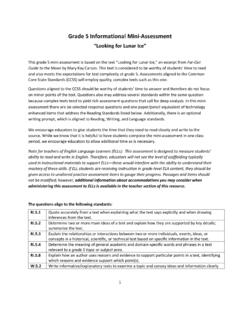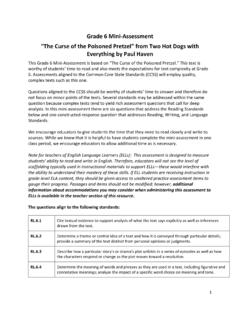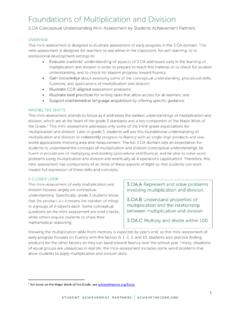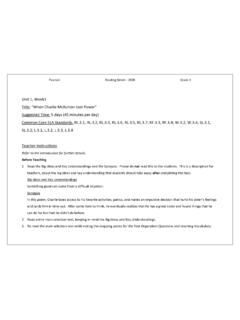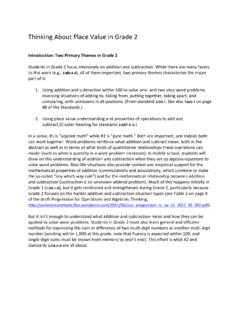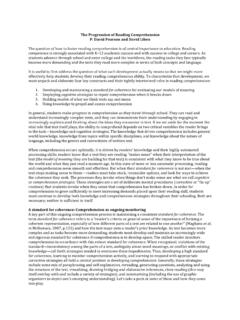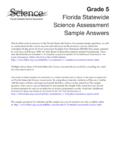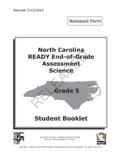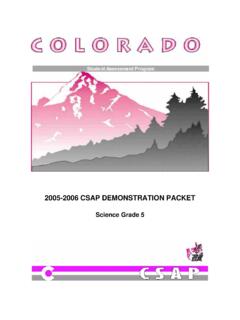Transcription of Grade 5 Informational Mini-Assessment “Bubblology”
1 1 Grade 5 Informational Mini-Assessment Bubblology This Grade 5 Mini-Assessment is based on a text about bubbles. This text is considered worthy of students time to read and also meets the expectations for text complexity at Grade 5. Assessments aligned to the Common Core State Standards will employ quality, complex texts such as this one. Questions aligned to the CCSS should be worthy of students time to answer and therefore do not focus on minor points of the text. Questions also may address several standards within the same question because complex texts tend to yield rich assessment questions that call for deep analysis. In this Mini-Assessment there are selected-response questions that address the Reading Standards listed below and one constructed-response question that addresses the Reading, Writing, and Language Standards.
2 There are also items that replicate how technology may be used on assessments, but in paper and pencil format. We encourage educators to give students the time that they need to read closely, answer the questions, and write to the source. Although we know that it is helpful to have students complete the Mini-Assessment in one class period, we encourage educators to allow additional time as necessary. Note for teachers of English Language Learners (ELLs): This assessment is designed to measure students ability to read and write in English. Therefore, educators will not see the level of scaffolding typically used in instructional materials to support ELLs these would interfere with the ability to understand their mastery of these skills.
3 If ELL students are receiving instruction in Grade -level ELA content, they should be given access to unaltered practice assessment items to gauge their progress. Passages and items should not be modified; however, additional information about accommodations you may consider when administering this assessment to ELLs is available in the teacher section of this resource. The questions align to the following standards: Quote accurately from a text when explaining what the text says explicitly and when drawing inferences from the text. Determine two or more main ideas of a text and explain how they are supported by key details; summarize the text.
4 Explain the relationships or interactions between two or more individuals, events, ideas, or concepts in a historical, scientific, or technical text based on specific information in the text. Determine the meaning of general academic and domain-specific words and phrases in a text relevant to a Grade 5 topic or subject area. Analyze multiple accounts of the same event or topic, noting important similarities and differences in the point of view they represent. Explain how an author uses reasons and evidence to support particular points in a text, identifying which reasons and evidence support which point(s). Write informative/explanatory texts to examine a topic and convey ideas and information clearly.
5 2 Produce clear and coherent writing in which the development and organization are appropriate to task, purpose, and audience. Draw evidence from literary or Informational texts to support analysis, reflection, and research. Demonstrate command of the conventions of standard English grammar and usage when writing or speaking. Demonstrate command of the conventions of standard English capitalization, punctuation, and spelling when writing. Use knowledge of language and its conventions when writing, speaking, reading, or listening. 3 Contents Grade 5 Mini-Assessment Bubblology : Print for Information for Teachers: Quantitative and Qualitative Analyses of the Question Annotations: Correct Answers and Distractor Using the Mini-Assessments with English Language Additional Resources for assessment and CCSS The assessment questions in this document align with the CCSS and reflect the instructional shifts implied by the standards.
6 To learn more about these topics, please go to the following link: 4 Grade 5 Mini-Assessment Bubblology Today you will read a passage about bubbles. You will then answer several questions based on the passage. I will be happy to answer questions about the directions, but I will not help you with the answers to any questions. You will notice as you answer the questions that some of the questions have two parts. You should answer Part A of the question before you answer Part B, but you may return to Part A if you wish. Take as long as you need to read and answer the questions. If you do not finish when class ends, come see me to discuss the ways you may have additional time.
7 Now read the passage and answer the questions. I encourage you to write notes in the margin as you read. Bubblology (b b l- l - j ) n. The study of bubbles. 1 There is a lot to be learned from a bubble! Bubbles can teach us about life, light and strength. The wall of a bubble has three parts. There is an outer wall made of soap or detergent, a center wall made of water, and an inner wall that is also made of soap or detergent. The inside of the bubble is filled with air. This structure of the bubble s wall is very similar to that of membranes found in living creatures like us. 2 Did you ever wonder how the food you eat gets from inside your stomach to inside your muscles?
8 To get to your muscles, the food must first be digested. Then it must pass through a set of membranes into your blood. The nutrients then circulate through your arteries to your muscles, where they pass through another set of membranes into your muscles. The next time that you blow bubbles, look for a cluster of them, and watch closely. If they don t pop too quickly, you will see that the air from the smaller bubbles will pass through the bubble wall into a larger bubble on the other side. This is very similar to the way that oxygen passes from your lungs through a membrane and into your blood stream. The larger bubbles are sturdier, because their walls are not curved as much as the walls of smaller bubbles.
9 3 Bubbles can also teach us about light. The light from the sun is made up of many different colors. Mixed together, they look white. However, it is possible to separate the different colors of light from each other with a prism. Small drops of water or ice crystals can work like a prism. You have seen this for yourself if you have ever seen a rainbow. The wall of a bubble can work the same way. That is why bubbles are iridescent. When light hits a bubble, it may look blue, or it may look red. The colors seem to dance around on the surface. The colors that we see depend upon the thickness of the wall of the bubble and how much it is bent. As water evaporates from 5 the bubble, the bubble s wall becomes thinner, and the colors change.
10 Also, as the wind blows a bubble around, its wall bends, changing the color. 4 Bubbles can also teach us how to make things stronger. Bubbles are usually very fragile. They can easily pop. But if we add sugar to the bubble solution, the bubbles are much sturdier. They will last for two or three times as long. This is because the sugar strengthens the wall of the bubble. The sugar dissolves in the water layer of the bubble s wall and takes the place of some of the water. Since the sugar does not evaporate as quickly as the water, the bubbles last longer. In addition, the sugar molecules are very large and stiff compared to water molecules. Like a large board nailed to the wall of a house, the sugar molecules brace the wall of the bubble to make it stronger.
